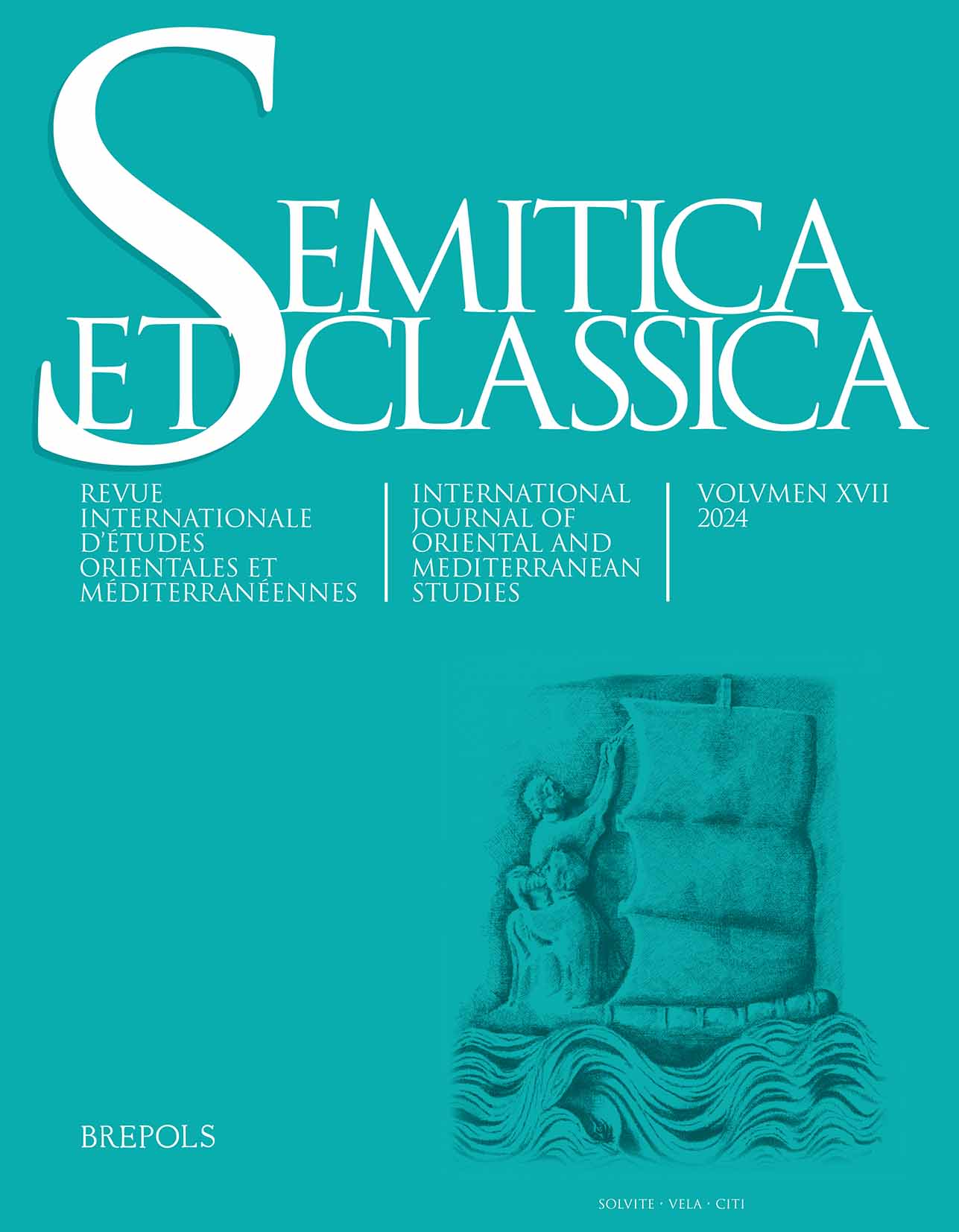Semitica & classica XVII 2024

Page de titre, sommaire, éditorial et résumés
- Sacrificial firewood in the ancient Mediterranean and beyond: a comparative analysis, p. 21
Moshe Blidstein
- Biblical typology and Hellenistic ideals: the figure of Joseph in Wisdom 2:12-20, p. 37
Jan Joosten
- Di Barca in Barca: Amilcare Brk/Brq e il toponimo Barqah/Barca a Palermo, p. 45
Claudio Vacanti
- Les pitiaxes : une institution princière des sociétés iranisées du Moyen-Orient ancien, p. 69
Nicolas Preud’homme
- Ancient South Arabian openwork bronze seals and a gypsum cretula preserved at the Museum Fünf Kontinente, Munich, p. 93
Giulia Buono
- Le miraculé de Baitokaikè et autres inscriptions religieuses de la Syrie côtière, p. 103
Julien Aliquot
- Les recensiones auctae de la Synopse de la Sainte Écriture faussement attribuée à Jean Chrysostome : les notices sur l’Octateuque, p. 125
Francesca Barone
- Au sujet d’une cosmographie étrange attribuée à Bérose, Rufin et Stomathalassa : histoire d’un mythe sur la destinée des âmes après la mort, p. 135
Émilie Villey
- Law and royal ideologies at play: essays on the Hebrew Bible and the Septuagint
- Biblical law, royal decrees and jurisdiction: linguistic and historical perspectives, p. 165
Anna Angelini, Romina Vergari
- The Torah of the king: negotiating royal and priestly authority in Deuteronomy 17:14-20, p. 171
Rodrigo de Sousa
- The reception of God’s Torah in the Pentateuch: a preliminary study of how later sections of Numbers understood divine law, p. 183
Peter Altmann
- Eastern, and ancient Greek texts, p. 195
Matthias Hopf
- LXX Exodus 22:4: between the Covenant code and Ptolemaic laws, p. 205
Camilla Recalcati
- From the “divine kiss” to the royal decree of the Lagids: πρόσταγμα, a case of vocabulary transfer in the Greek Bible, p. 213
Cécile Dogniez
- The Law in dialogue with the Graeco-Roman world: women’s behaviour in Philo of Alexandria’s On the special laws, p. 221
Francesca Pezza
- La Septante, histoire du texte et enjeux pour l’exégèse
- Avant-propos, p. 237
Béatrice Oiry
- La Septante et les questions liées à la traduction du texte biblique, p. 239
Ștefan Munteanu
- Erreurs de lecture ou choix de traduction ? Remarques sur le texte de LXX Ex 38,26, Gn 49,14 et Nb 24,7, p. 247
Charles-Antoine Fogielman
- Texte massorétique et Septante, une double interprétation de la visite de la reine de Saba à Jérusalem dans le premier livre des Rois, p. 253
Emanuelle Pastore
- La double création en Gn 1-3 selon les Septante, p. 261
Stéphane Beaubœuf
- La pluralité textuelle des Écritures : le regard des auteurs juifs et chrétiens de l’Antiquité, p. 267
Sébastien Morlet
- Lieux de mémoire de la Septante : la Torah du Sérapéum, p. 281
Laurence Vianès
- Note à propos d’un vase à épigraphe phénicienne trouvé à Tell el-Herr (Nord-Sinaï), p. 291
Catherine Defernez, Mitchka Shahryari, Robert Hawley
- The Roman annexation of the Nabataean kingdom: a Safaitic witness, p. 303
Ahmad Al-Jallad, Michael C. A. Macdonald
- A Greek graffito from Wādī Rāǧil (northeast Jordan), p. 313
Rafe Harahsheh, Julien Aliquot, Hani Hayajneh
- Un nouveau graffite nabatéen de la Ḥarra jordanienne, p. 317
Hani Hayajneh, Rafe Harahsheh, Maria Gorea
- Hommages
- René Marcel Sigrist (1940-2024), p. 323
Philippe Abrahami
- Maria Giulia Amadasi Guzzo (1940-2024), p. 327
Nicola Chiarenza, Bruno D’Andrea, Adriano Orsingher
- Natalio Fernández Marcos (1940-2024), p. 329
Cécile Dogniez
- Étienne Nodet (1944-2024), p. 331
Hedwige Rouillard-Bonraisin




